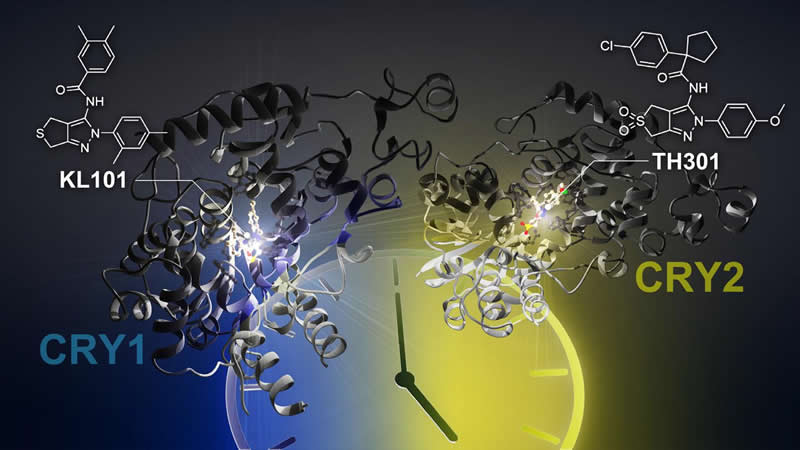Summary: Two small molecules, KL101 and TH301, are the first compounds that selectively target circadian clock components CRY1 and CRY2.
Source: ITBM
The circadian clock controls a variety of biological phenomena that occur during the course of the day, such as sleeping and waking. Perturbation of the circadian clock has been associated with many diseases such as sleep disorders, metabolic syndrome, and cancer. The development of small-molecule compounds to regulate specific components of the circadian clock facilitates the elucidation of the molecular basis of clock function, and provides a platform for the therapeutic treatment of clock-related diseases.
In this study, the research team discovered the small molecules, KL101 and TH301, that lengthen the period of the circadian clock. They found that KL101 and TH301 are the first compounds that selectively target clock components CRY1 and CRY2, respectively. By utilizing X-ray crystallography to determine the structures, they revealed how KL101 and TH301 bind to CRY1 and CRY2.

However, additional experiments were required to determine the mechanism of CRY1 and CRY2 selectivity. It was found that the disordered tail regions of CRY proteins impart compound selectivity. Additionally, in collaboration with Project Associate Professor Megumi Hatori and Postdoctoral Fellow You Lee Son of the Keio University School of Medicine, they found that CRY1 and CRY2 are required for the differentiation of brown adipocytes, and both KL101 and TH301 are expected to provide a promising foundation for the therapeutic treatment of obesity.
Source:
ITBM
Media Contacts:
Dr. Tsuyoshi Hirota – ITBM
Image Source:
The image is credited to Issey Takahashi | ITBM, Nagoya University.
Original Research: Closed access
“Isoform-selective regulation of mammalian cryptochromes”. Simon Miller, You Lee Son, Yoshiki Aikawa, Eri Makino, Yoshiko Nagai, Ashutosh Srivastava, Tsuyoshi Oshima, Akiko Sugiyama, Aya Hara, Kazuhiro Abe, Kunio Hirata, Shinya Oishi, Shinya Hagihara, Ayato Sato, Florence Tama, Kenichiro Itami, Steve A. Kay, Megumi Hatori & Tsuyoshi Hirota.
Nature Chemical Biology doi:10.1038/s41589-020-0505-1.
Abstract
Isoform-selective regulation of mammalian cryptochromes
CRY1 and CRY2 are essential components of the circadian clock controlling daily physiological rhythms. Accumulating evidences indicate distinct roles of these highly homologous proteins, in addition to redundant functions. Therefore, the development of isoform-selective compounds represents an effective approach towards understanding the similarities and differences of CRY1 and CRY2 by controlling each isoform individually. We conducted phenotypic screenings of circadian clock modulators, and identified KL101 and TH301 that selectively stabilize CRY1 and CRY2, respectively. Crystal structures of CRY–compound complexes revealed conservation of compound-binding sites between CRY1 and CRY2. We further discovered a unique mechanism underlying compound selectivity in which the disordered C-terminal region outside the pocket was required for the differential effects of KL101 and TH301 against CRY isoforms. By using these compounds, we found a new role of CRY1 and CRY2 as enhancers of brown adipocyte differentiation, providing the basis of CRY-mediated regulation of energy expenditure.






